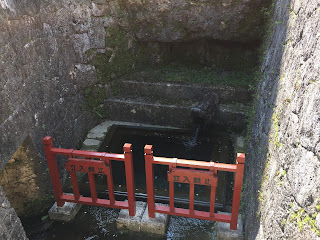首里城の表玄関とも言える守礼門と、城郭内に入るための歓会門との中間地点あたりの左手にある、園比屋武御嶽石門。
その古さびた佇まいは、明らかに再建された、と見て取れる他の建物とは、全く違った雰囲気を作り出している。
この門は、琉球王国の第二尚氏、第3代国王尚真王の時代に作られた。
もともとは、この門の背後には、園比屋武御嶽が広がっており、王が城を出る際に、この門から御嶽に礼拝する、聖なる門だった。
この門を作ったのは、竹富島出身の西塘という人物で、尚真王の八重島侵攻時に活躍した人物で、石工技術などの様々な技術に長けていたという。
この門は、戦前に国宝に指定されたが、太平洋戦争で破壊されて指定を解除された。
戦後、残っていた石を一部使って再建されて、重要指定文化財に指定され、2000年には首里城跡などとともに、世界遺産に指定された。
第3代国王尚真王の時代は、琉球王朝の最盛期と言われる。
その時代の雰囲気を今に伝える、貴重な存在であることに、間違いはない。
And Shurei Gate also said front door of Shuri Castle, located in the left hand per intermediate point between kankai Gate to enter into the castle, Sonohyan-utaki Shimen.
The old rusty appearance was apparently rebuilt, and other buildings that be seen as, and has created an entirely different atmosphere.
This gate, the second Hisashi of Ryukyu Kingdom, was made in the era of the third generation king Naoshin.
Originally, Behind this gate, Sonohyan-utaki has spread, when the king leaves the castle, to worship from this gate to Mitake, it was a holy gate.
It was to be made this gate, in the person named Xitang born Taketomi, in the dominating person at the time of Yaeshima invasion of Naoshin-o, and that was good at a variety of technologies, such as masonry technology.
This gate is, has been designated a national treasure before the war, it has been de-designated and been destroyed in World War II.
After the war, it is rebuilt using some of the remaining have been stone, is designated as an important cultural property designation, in 2000 with such Shuri Castle Ruins, it has been designated a World Heritage Site.
Era of third generation king Naoshin-o, it is said to be the golden age of the Ryukyu Kingdom.
Convey the atmosphere of that era to now, to be a valuable presence, definitely not.
(Translated by Google Translate)








